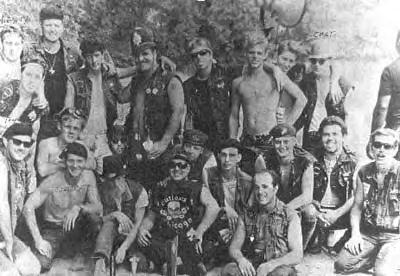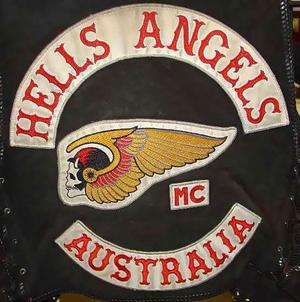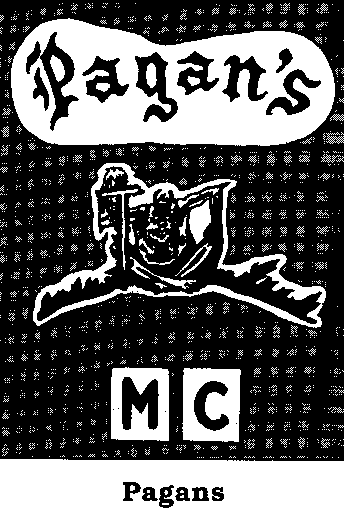One Percent Biker Gangs of the 1950's
From fifties
[edit] One Percent Biker Gangs
After world war two, many soldiers returned home to the challenge of adjusting back to the slower-paced civilian jobs and peace of life. Many having been exposed to motorcycles in the war, plus the increasing cost of gas and transportation back home, motorcycles were the obvious choice for many. Not only as affordable means of travel but sometimes more importantly a form of accelerated recreation. As these two-wheeled machines became more accessible, motorcycle clubs gained in popularity as motorcyclists joined together for strength in numbers and peer acceptance. The first major motorcycle club was the AMA (American Motorcycle Association) which was funded in 1924. Most members were generally good-mannered, law abiding citizens- as the AMA discouraged trouble of any kind (which certainly helped avoid bad press coverage). It was not until the events and repercussions of the AMA sponsored Gypsy tour held in Hollister, California on July of 1947 that had historically divided the club into two parts- one percenters and everyone else (ninety-nine percenters). The meaning of both terms can be understood from an important statement made by the AMA during a press conference that was immediately held afterward in order to better explain the events that took place in Hollister. After much rambling and evasion of some rather embarrassing questions, they had quoted- “The trouble was caused by the one percent deviant that tarnishes the public image of both motorcycles and motorcyclists”. The AMA could not be blamed for the actions that took place in Hollister; so they placed the blame on the small group of weirdoes within the club. They were the ones who rode “chopped” or “bobbed” bikes and wore old military attire consisting largely of bomber or field jackets (some of the more common biker wear of that era). It came down to the harassment of those who rode these particular styles of machines within the club, and in some cases were even denied entry to AMA sanctioned events. To be treated in this manner was simply unacceptable, considering most of these men had just returned home from fighting a war. Eventually the wives and girlfriends of these men began hand sewing small 1% patches that were adorned on the sleeves of their coats. This infuriated the AMA leadership which stepped up their “discouragement” policy in retaliation. This culminated until the one percenter’s disbanded and formed separate motorcycle clubs (MC) outside the AMA. Membership in an “MC” was far different then membership in a motorcycle club. To belong to an MC was to belong to the counter-culture “outlaw” biker lifestyle; committed to biking and brotherhood. Often times the structure of a motorcycle club is typical- there is a president and vice-president, a treasurer, a secretary, road captain and sergeant-at-arms. There exists chapters (at least a six member minimum, and twenty-four member maximum before splitting into a new chapter) which is defined by a large group of MC’s that belong to specific area/ territory. Mother chapters are the first chapter established for that particular MC. The president of the mother chapter presides as president over the entire MC; setting the rules and policies on various issues. In modern times there exists five major MC’s in the United States. These clubs are largest in membership and chapters which consist of the Outlaws, Hell’s Angles, Pagans, Banditos, and Sons of Silence MC’s. Of these five, there are only three that had begun in the 1950’s, if not earlier. The Outlaws MC (originally the McCook Outlaws Motorcycle Club, then the Chicago Outlaws in the 1950’s) is the oldest, first proclaimed 1% MC, started in 1935 out of McCook, Chicago Illinois. In 1963 they became an official part of the 1% brotherhood of clubs- the first true club east of the Mississippi. They are bitter enemies with the Hells Angles- constantly at war and killing each other. Although in better times Danny Lyon (a former outlaws MC member in the mid sixties) can remember when the Hells Angles were more brothers than enemies with the Outlaws. Although second to oldest, the Hells Angles are the most predominant and numerous MC club, both nationally and worldwide (considered being the largest 1% club in the world). Other names the Hells Angles are known by are “local 81” after the placement of the letters in the alphabet, and the “big red machine”. Their club logo, the winged death skull, is protected by copyright as they have been known to sue over the protection of this logo- it can only be worn by other members. The first Hells Angles chapter was formed in San Bernidino, California on March 17, 1948 by world war two veterans who were former members of the “Pissed-off Basterds of Bloomington”. Without previous knowledge of the Hells Angles MC existence, Ralph “Sonny” Barger and his gang of young toughs formed the present day Hells Angles MC in Oakland, California in 1957. Within the next ten years, the Oakland MC chapter became the mother chapter- disbanding or taking in the other chapter. The Hells Angles are a particularly rough group of outlaw motorcycle gangs, many of their chapters and puppet-gangs (smaller MC groups in support of) being involved in narcotics, prostitution, major armed robberies, movement of arms and explosives, assaults and murders. Last but not least, the Pagans MC was formed in 1959 by Lou Dobkins who was actually a bio-chemist at the national institute of health in Prince George’s county, Maryland. The original Pagans were not a 1% biker club when founded; the original thirteen members whore white denim jackets with a logo of a Pagan Fire giant carrying a flaming sword. The original members also rode Triumphs (by today’s standards, no 1% MC’s ride foreign bikes) and by 1965 this benign motorcycle club had evolved into a fierce 1% MC with ties to the Mafia. The Pagans are also at war with the Hells Angles, as they are “patching over” Pagan members in their traditional Pagan stronghold. Among other bikers the Pagans carry a general reputation of being very reclusive and having very little to do with other clubs. Their natural inclination for violence reinforces this reputation. Women in MC’s cannot become full-patched members, but can still hold special statues within the club. Memberships in outlaw motorcycle gangs are often sexist as well as racist. Few exceptions to this are the Mongols MC, which was started as a Chicano prison gang in East Los Angeles in the early 1970’s. They are predominantly Mexican with a large number of former street gang members, which makes them a particularly violent MC. There also exists at least four Black or interracial 1% biker clubs, which includes the Oakland, California East Bay Dragons MC (all black), Wheels of Soul MC (founded in 1976) comprised of Black, White, Latino and Asian members; the only MC of its kind. The Ching-a-Lings MC in Queens, New York and the Black Ghetto Riders MC of Camden county are also inter-racial motorcycle gangs. Unfortunately, none of these MC’s date back any further than the early 1970’s. The three outlaw motorcycle clubs (Outlaws, Hells Angles, Pagans) that began it all are still in full effect and growing to this day- some larger then others but non-the-less dangerous and willing to stab, maim, grind, shoot, tear, torture or even kill those who threaten their territory or ways of life.






